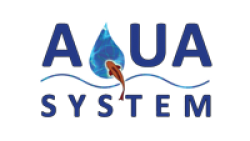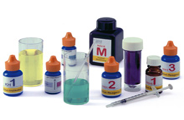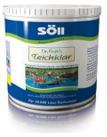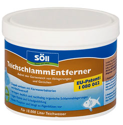Green algae (green water)
Autumn and winter are difficult times for the pond. A lot of nutritious get into the pond such as falling leaves, also a lot of soft water which dilutes pond water and reduces temporary hardness of water.
If water is insufficiently stabilized, in spring, algae may bloom and this will lead to sudden and serious increase of pH. Too high value of pH has very negative influence on fish’s health and whole ecosystem.
Self-cleaning mechanisms and ecological processes can only function properly in sufficiently hard and buffered pond water (pH 7.5 – 8.5, temporary hardness over 5°). Fluctuation of pH value may cause reduction of variety of species and also mass growth of some kinds of algae. PH fluctuation may also negative influence on zooplankton – an enemy of algae. These are main reasons upsetting proper functionality of garden reservoirs. That’s why it is so important to prepare your pond before winter season.
STEP 1 -pH, CH and nitrite check
The upset balance in the pond has important influence on algae growth. If temporary water hardness is over 5 and pH 8.3 water is stable and all substances contained in water (such as nitrite, nitrate, ammonia etc) are not harmful. Moreover activity of anti algae agents is limited in alkaline water (pH > 8.5). Fist of all it is necessary to check pH and CH (temporary hardness of water). It is recommended to run two tests, fist one in the morning (around 7am) and second in the afternoon (around 7pm). You can run the test using simple Soll testers, AquaCheck Soll suitcase or simply bring your water sample to the distributor point.
Test results:
- If pH value is in range 7.4 – 8.4° and CH is over 5° it means that all parameters of water are correct -GO TO STEP 3
If pH is high (over 8.4°) or low (less than 7.4°) and we observe substantial fluctuations between morning and evening tests (pH value is lower in the morning) or CH (temporary hardness ) is low (below 5°) – GO TO STEP 2 - As a next step you should check nitrite content. This check should be carried always at the same time (preferably in the evening). Test should be postponed in case of rain for at least 2 days. You can run the test using simple Soll testers, AquaCheck Soll suitcase or simply bring your water sample to the distributor point.
Test results:
- If nitrates content crossed 0.3mg/l than 30% of water should be exchanged – preferably with tap water conditioned with TeichStarter.
- If nitrates content crossed 0.7mg/l then over 60% of water should be exchanged – preferably with tap water conditioned with TeichStarter.
- If nitrates content crossed 1mg/l exchange of whole water is recommended and than condition with TeichStarter.
STEP 2 – STABILISATION OF KEY PARAMETERS OF WATER (EVENTUALLY WATER CONDITIONING).
Option 1
PH Value too low or too high, CH too low, no water exchange (nitrates content below 0.1mg/l)
TeichFit® contains active CarbonAdd which optimizes and stabilizes main parameters of water: pH, temporary hardness and calcium content. Visible results may be observed just 3 days after use, variety of species and microorganism thus eliminates harmful substances. Moreover, TeichFit® immediately neutralizes heavy metals.
Option 2
PH Value too low or too high, CH too low, no water exchange (nitrates content above 0.3mg/l)
In case of partial exchange of water it’s better to refill the pond with tap water rather than well water. In this case fresh water should be conditioned first (tap water, rain water or well water) to the level complying with biotope (all harmful substances such as chloride or heavy metals which may have negative influence on pond life are bonded, pH value should be stabilized and temporary hardness of water is increased and pH value doesn’t fluctuate). Improper parameters of water cause increase of ammonia toxicity. This can lead to serious fish diseases, mass growth of algae, increase of sludge and finally to degradation of water environment.
You can use TeichStarter to condition water (tap water, rain water or well water) up to the level which complies with biotope of pond water; to bond harmful substances, chloride or heavy metals which can have negative influence on pond life, also to increase temporary hardness and creates proper environment for all pond occupants.
STEP 3 – ABSORPTION OF PHOSPHATES, AMMONIA AND HEAVY METALS
To protect your pond from algae it’s necessary to use agents which absorb phosphates, ammonia and heavy metals.
Tap water contain up to 6.5mg/l of phosphate. Phosphate protects from corrosion and lime in pipes and instruments. Well water contains up to 4 times more phosphates.
Water biologically free from germs gives filamentous algae and green algae maximum advantage during absorbing nutritious substances (food, pollens, sludge, etc). In case the concentration of phosphate (PO43) is greater than 0.035mg/L mass growth of algae can increase. 1 kg of algae can arise from 0,1g of phosphates!!!
Phosphates cannot be sufficiently filtrated; may only be eliminated in precipitation and bonding processes.
Purified zeolite or ZeoSpeed are recommended agents which bond phosphates (PhosLock AlgenStopp®).
ZeoSpeed® is a multi-ply, renewable and highly efficient zeolite. Bonds ammonia and phosphates; may be used in filter or directly in pond water. Each zeolite has limited capacity and usually works for approx. 6-8 weeks. Then needs to be changed or regenerated with ZeoPower.
PhosLock AlgenStopp® is strongest bonding agent in the world. Continuously reduces phosphate volume (main algae nutrition) to the level below 0,035mg/L thus reduces mass algae growth. It has to be applied on a regular basis every 6 weeks.
STEP 3 – CREATION OF BACTERIAL FLORA
In both cases when filtration system is installed (filter, UVC lamp and filtrating pump) or is not installed, biological life of the pond may be made alive by using of bacterial starters. Those agents help in creation of bacterial flora which is essential in biological cleaning process. Cultures of bacteria which are taking part in a self cleaning process can appear in a pond after 6-8 weeks. Bacteria starter shortens this period to 1 week.
Pond without filtrating system
In case of ponds which are not equipped in filtrating system it is highly recommended to use Dr. Roth’s®Teichklar. This agent contains wide variety of microorganisms which enrich biological life in the pond. This increases biological capacity of decomposition of organic substances polluting pond water and slime. This agent also reduces algae blooming and prevents putrefaction and reduces creation of harmful gases. Should be applied regularly every 4 weeks.
Pond with filtrating system
BioBooster® takes care of settlement of highly active bacteria cultures thus quickly removes toxic concentration of nitrogen from both pond and filters. That helps to create bacterial flora – essential in biological filtration process, reduces activation time of pond filters. At the same time it is recommended to use FilterStarterBakterien to activate bacterial flora in a filter. Properly selected microorganisms immediately activate biological cleaning mechanism in pond water.
Bacteria can only be strained if average water temperature is over 8°C. Before applying the agent it is necessary to switch of the UVC lamp. Lamp can be again switched on after 48 hrs.
STEP 5 – slime removal from pond bottom
TeichschlammEntferner is purely mineral and is responsible for removal of organic slime.
Spring as well as autumn is a good time for removing bottom sludge arising from putrefactive processes of leaves, remains of food, fish’s excrements. Mechanical slime removal isn’t efficient in a longer period of time, it also upsets slime layers and releases harmful ammonia. Thus it is recommended to use such product which will quickly and effectively decompose the sludge -i.e. TeichschlammEntferner of Söll – see more in “Biological slime removal” .
STEP 6 – PROTECTION AGAINST ALGAE
Mass growth of algae in water reservoirs is the most common problem. It is very difficult and time consuming to control its growth. At the moment there are over 100 000 known algae. The most common are: suspension algae, cyanobacteria, flagellates and filamentous algae. Algae are not only ugly but may also produce harmful toxic substances being dangerous for fishes. Researches prove that metabolic poisons of cyanobacteria may be dangerous for people – can lead to various allergies, eczema as far as serious nerves damages. Algae removal is onerous so it’s much easier to fight with algae at the earliest stage. Anti-algae agents and phosphate bonding agents should be used. Unfortunately most of available anti-algae agents are only effective on certain kind of algae; they are often harmful for fishes and plants; they only reduce algae but not protect against them. Most of agents are not effective in alkaline water (pH > 8.5°)
AlgoSoll® is the only available agent which is effective on all kinds of algae and additionally protects reservoir against its growth.
How to choose best agent:
- AlgoSoll® – in case low volume of algae
- AlgoSol® Forte – in case of large volume of algae
AlgoSol® fights against all kinds of algae (green algae, filamentous algae, flagellates) and if used regularly effectively protect your pond against its growth. Active substances Active substances contained in AlgoSol® stop sunlight which is necessary for photosynthesis (SpectroSorp process) on one hand and from the other hand allow carrying out essential biological regulation process and metabolism. Algae are starved. This agent may be used at least 24hrs after or before using TeichFit.
AlgoSol® Forte works similar to AloSol® but contains much more condensation of active agent thus can only be used in case of large volume of algae. AlgoSol® then can be used for prevention against further growth.








